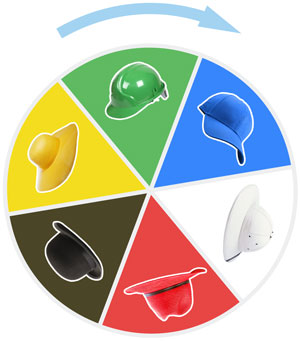How do you instinctively approach decision-making? Are you a natural optimist? If so, you may not always consider potential downsides. Are you generally risk-averse? Then you might miss out on new opportunities available to you.
Having a rational, positive viewpoint does indeed go a long way in helping people reach successful outcomes, but considering a problem from other angles also pays off. Looking at problems from emotional, intuitive, creative, or risk-managing viewpoints can also help lead you to solutions not discovered. Perhaps more importantly, failing to consider these perspectives could lead you to underestimate people’s resistance to your plans, fail to make creative leaps, or ignore the need for contingency plans.
The Benefits of Six Thinking Hats
More Complete Thinking
This method, developed by Edward de Bono, helps leverage more complete thinking. In the Six Thinking Hats, each hat represents a different perspective:
White Hat: the facts and figures
Red Hat: the emotional view
Black Hat: the “devil’s advocate”
Yellow Hat: the positive side
Green Hat: the creative side
Blue Hat: the organizing view
To get a great visual representation of the Six Thinking Hats method, click here.
If you think of the problem as a pie, then each hat or perspective is a slice of the pie. By cycling through the hats, you get a more complete view, and this can be done in the business world as well as practiced in the classroom by following three simple steps.
More Collaborative Meetings
By using the Six Thinking Hats, everyone is thinking about the problem in a collaborative way by assuming the same perspective (hat) at the same time. The group then focuses on one specific viewpoint for a set time before moving on to the next. This ensures that a problem is being looked at from multiple specific angles and that the people on your team are utilizing different perspectives in a safe and constructive way.
The six thinking hats can also be applied to different scenarios based on the aim of the discussion. Educators can teach students creative thinking and solution-building based on an in-depth understanding of problems.
How to Execute Six Thinking Hats in Steps
You’ll want to set up a simple process to help guide your team or class without having to explain all the details of Six Thinking Hats. The key is to list focus questions for everyone to cycle through. Here are three simple steps to help you get going:
Step 1. List the questions that represent the hats
List a set of questions on a whiteboard or projector representing each of the hats. Here are some example questions that you can use:
- What are the facts and figures?
- What’s your gut reaction? How do you feel about this?
- Why can’t we do this? What prevents us? What’s the downside?
- How can we do this?
- What are additional opportunities?
- How should we think about this?
Step 2. Walk through each question as a team
Reviewing each question as a team is crucial because rather than debating each other, you’re now collaborating. Even members of your team that are usually risk-averse, for example, can help out the team by offering ideas based on all the hats. Both you and your team may be surprised at the amount of participation you’ll get from team members who have the chance to focus on a different perspective!
Step 3. Modify the approach
If you find that something isn’t quite working, go ahead and change up the approach. You might discover, for example, that your team started with the wrong hat or question. Try opting for a different question. The key to this strategy is to keep your debate focused and deliberate, as teamwork should be.
The Six Thinking Hats technique aims to get the most out of critical thinking discussions. Through organization, everyone involved in the process can be sure that the problem is being covered from multiple angles and from different points of view. This organized thinking approach occurs in a small period of time to reach the best possible output, and ultimately moves towards building creative solutions and innovative approaches for solving problems.
Here’s a decision that’s easy to make: Click to watch a free demonstration of what your school can do with Gradelink!

